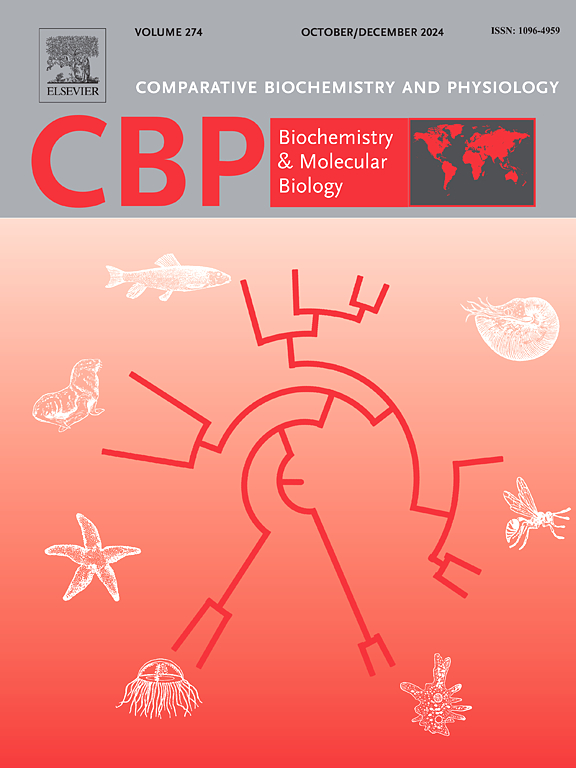黄腐酸对斑马鱼生长、免疫和抗氧化状态的影响。
IF 1.9
3区 生物学
Q4 BIOCHEMISTRY & MOLECULAR BIOLOGY
Comparative Biochemistry and Physiology B-Biochemistry & Molecular Biology
Pub Date : 2025-01-19
DOI:10.1016/j.cbpb.2025.111073
引用次数: 0
摘要
本实验旨在研究黄腐酸(FLA)对斑马鱼(Danio rerio)生长性能、先天免疫系统、抗氧化参数以及免疫和抗氧化相关基因表达的影响。为此,选择12个槽(每组3个),每个槽中有50尾平均体重为85.7 ± 10.05 mg、72 L的斑马鱼,分别饲喂0(对照)、0.25 (FLA1)、0.5 (FLA2)和1 (FLA3) g/kg的饲料。8周培养后,各处理组的生长性能无显著差异(P > 0.05)。但与其他处理相比,0.5-1 g FLA/kg饲粮组溶菌酶活性、总免疫球蛋白(Ig)和总蛋白浓度显著提高(P 0.05)。添加FLA显著上调了干扰素-α (IFN-α)和肿瘤坏死因子-α (TNF-α)的基因表达,其中以0.5 g FLA/kg饲粮组表达量最高(P 0.05)。CAT基因表达在各组间保持一致(P > 0.05)。相反,SOD基因表达在饲粮中均显著升高,以0.5 g FLA/kg组最高(P本文章由计算机程序翻译,如有差异,请以英文原文为准。

Effects of fulvic acid on zebrafish (Danio rerio) growth, immunity and antioxidant status
This experiment aimed to determine the efficacy of fulvic acid (FLA) on growth performance, innate immune system, antioxidant parameters, and expression of immune and antioxidant-related genes in zebrafish (Danio rerio). To this end, 12 tanks (3 per group), each containing 50 zebrafish (with an average weight of 85.7 ± 10.05 mg) in 72 L, were assigned to diets containing FLA at four levels: 0 (control), 0.25 (FLA1), 0.5 (FLA2), and 1 (FLA3) g/kg diet. Following an eight-week culture period, no significant differences in growth performance were observed among the treatment groups (P > 0.05). However, lysozyme activity, total immunoglobulin (Ig), and total protein concentrations in whole-body extracts were significantly enhanced in the 0.5–1 g FLA/kg diet groups compared to the other treatments (P < 0.05). No significant differences were observed among the groups in catalase (CAT), glutathione peroxidase (GPx), or superoxide dismutase (SOD) activities (P > 0.05). The supplementation of FLA significantly upregulated the gene expression of interferon-α (IFN-α) and tumor necrosis factor-alpha (TNF-α), with the highest expression observed in the 0.5 g FLA/kg diet group (P < 0.05). Additionally, interleukin 1 (IL-1) expression was markedly elevated in this group in comparison to the other treatments (P < 0.05). While there was a significant increase in GPx gene expression with dietary FLA (P < 0.05), no notable differences were observed among FLA treatments (P > 0.05). CAT gene expression remained consistent across all groups (P > 0.05). In contrast, SOD gene expression significantly increased in response to all FLA-supplemented diets, with the highest level observed in the 0.5 g FLA/kg group (P < 0.05). These findings suggest that FLA may serve as an effective dietary supplement to enhance the immune response and antioxidant capacity in zebrafish.
求助全文
通过发布文献求助,成功后即可免费获取论文全文。
去求助
来源期刊
CiteScore
4.60
自引率
4.50%
发文量
77
审稿时长
22 days
期刊介绍:
Comparative Biochemistry & Physiology (CBP) publishes papers in comparative, environmental and evolutionary physiology.
Part B: Biochemical and Molecular Biology (CBPB), focuses on biochemical physiology, primarily bioenergetics/energy metabolism, cell biology, cellular stress responses, enzymology, intermediary metabolism, macromolecular structure and function, gene regulation, evolutionary genetics. Most studies focus on biochemical or molecular analyses that have clear ramifications for physiological processes.

 求助内容:
求助内容: 应助结果提醒方式:
应助结果提醒方式:


